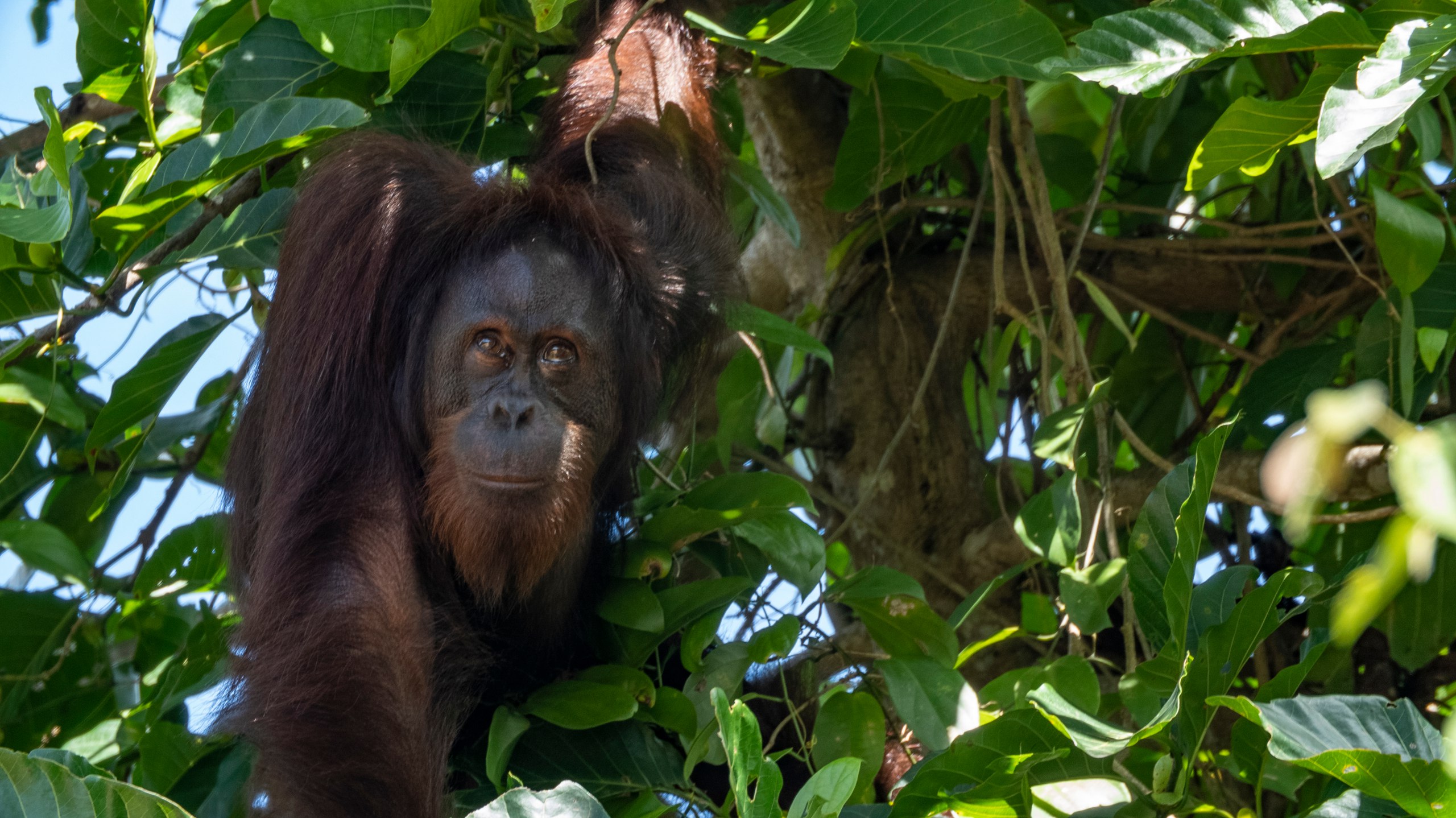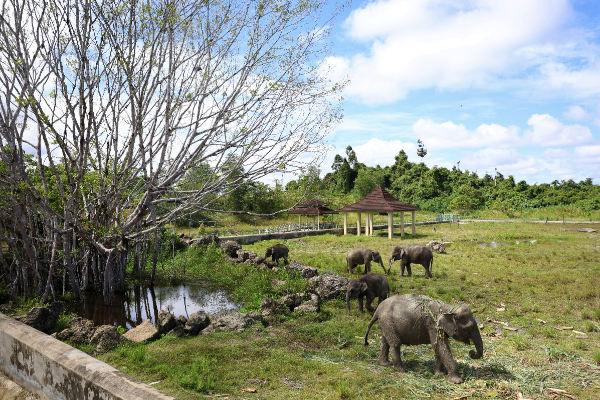John Payne and Zainal Zahari Zainuddin
Borneo Rhino Alliance (BORA),
c/o Faculty of Science and Natural Resources,
Universiti Malaysia Sabah,
Jalan UMS,
88400 Kota Kinabalu, Sabah, MALAYSIA
The Malaysian oil palm industry certainly faces many challenges, both domestically and internationally. One rather small but seemingly never-ending issue could potentially be addressed – if the issue can be clearly understood and acted upon.
This article makes a plea for a new approach to help put to rest the perennial arguments over oil palms and orangutans. As with most issues that never seem to be resolved, there are pros and cons on both sides, and unwillingness to work towards, firstly, a common, truthful understanding and, secondly, a way forward to resolve the issue. What exactly is the point of disagreement? Here, we face the first obstacle to the discussion: there are many outlandish claims. Those can be discounted. But the essence is: the total wild orangutan population has declined by a very large number (some say by 50% over the past few decades) and that the decline has occurred mainly through the conversion of rainforests to plantations, most of which happen to be of oil palm. Some years ago, one of the responses from Malaysia was to claim that oil palm plantations were developed only or mainly on former rubber and cocoa plantations, a claim that is patently false, thereby generating a feeling in ‘the West’ that the Malaysian response on this issue cannot be trusted. More recent claims have been that hunting of orangutans has played a bigger role than forest loss in this species decline. Oddly, this claim
has been made by both government and some NGOs (non-governmental organisations). In some particular areas, the claim may be true, but on the entire regional scale, this seems doubtful. More recently, we have seen an argument that all wildlife – not just orangutans
– is threatened across the world and that changes in land in the Asia Pacific make up only 43 percent of the factors threatening wildlife populations. This is a case of ‘whataboutery’, and still does not move the debate forward.
The main reasons for the orangutan decline in Sabah (where the bulk of orangutans in Malaysia occur) are so simple as to be frequently ignored. One is the growing human population both in Malaysia and globally. Another is the demand for cheap vegetable oils outside the region. A third is that loss of forests to oil palm does not happen either willy-nilly or because of nasty motives by corporations. The fact is that specific land areas are allocated by governments as a matter of policy for human use, including but not only for oil palm plantations. And finally, the fact that oil palm replaces forest instead of some other crop is due to its utility in producing vegetable oils, and not because of some inherent badness in this particular plant species or its products.
Before proceeding to a suggested new approach, some information on orangutans needs to be presented. Firstly, fossils show us that orangutans were once widespread through much of Southeast Asia, including southern China, southwards to the land that is now Peninsular Malaysia. The species disappeared from this entire region tens of thousands of years ago, long before the spread of humans and agriculture. In any case, it is utterly implausible that humans could have hunted the species to extinction over hundreds of millions of hectares, although hunting to extinction might have occurred locally. It is also implausible that all those prehistoric orangutans lived in tropical rainforests. Most of the vast Southeast Asian mainland was covered in sub-tropical forests with a seasonal climate over the hundreds of thousands of years that orangutans were present. Male orangutans grow to a much larger size than females: on average over 80 kg for males, less than 40 kg for females. Yet in general, their diet is the same. In humans and most other mammals, on average males grow to be only slightly larger than females. Zoologists usually argue that in species where adult males are much larger than adult females – a very rare feature in the animal world – the large size of the former is an evolutionary outcome of physical competition between males for females. While wild mature male orangutans do occasionally fight each other, that is very rare. They prefer to avoid conflict. Instead, their large body size may allow them to travel further, over bigger areas, seeking opportunities to mate with females who are resident in their very much smaller individual home ranges. Very occasionally, humans report seeing a wild orangutan in remote sites where orangutans have not been seen previously. Examples of such cases occur from time to time in the forests of central Borneo, northern Sarawak, and south-western Sabah. These orangutans are mature males, traveling over great distances, seeking female orangutans where, albeit unknown to the males, there are none. Whatever the evolutionary reason, male orangutans do seem to be extraordinarily large for a species that spends most of its time in trees.
Studies of wild orangutans reveal that while males may spend their lives in areas ranging from a few hundred to many thousands of hectares, females spend their lives in much smaller areas – in some cases smaller than 100 hectares. In difficult times, such as in El Nino drought years or El Nina very rainy years, they tend to stay put, awaiting better times even though there may be no fruits or young leaves within their home range over a period of a year or more. We could imagine that, over periods of tens of thousands of years, occasional periods of bad weather – perhaps a very wet year followed by a very dry year, experienced over millions of hectares – could result in starvation of all the female orangutans present, and extinction on a regional scale.
Irrespective of the above speculations, it is true that modern orangutans do need tropical rainforests in which to live and reproduce. All serious studies of the species in the wild do show that. In these forests, their diet is roughly 40 percent fruits of many species, 40 percent young leaves also of many tree and liana species, and 20 percent other foods including cambium (when there are not many fruits or young leaves in the forest) and insects. But they cannot survive in just any rainforest. There are large areas of central Borneo where there have been no orangutans in recent times and only very sparse human activity. It seems likely that in those areas, the natural production of fruits and leaves in the rainforest plants may be too sparse to permit an orangutan population to thrive.
In recent decades, their optimum habitat was the flat lowlands. Numerous studies have shown that in the forested lowlands, and in the absence of hunting, the population density of orangutans was and still is one to two individuals per square kilometre. That is about the same as the human population density of Mongolia and lower than that of Iceland. In hill forests, in contrast, orangutan population density is around one orangutan per 2 square kilometres or less. That is about the same as the human population density in the Sahara Desert. These are natural population densities, linked to the natural supply of orangutan foods in the forest.
This observation is analogous to the density of oil palms in a plantation, of about 14 000 palms per square kilometre. Just as it is not feasible to boost wild orangutan population density to, say, 100 per square kilometre (the human population density in Malaysia), it is not feasible to squeeze 1.4 million oil palms (14,000 x 100) into a square kilometre of plantation land. There is an upper limit to the carrying capacity of any piece of land, for plants and animals alike. Only humans are unique in this respect.
Although actual data are not available in the public domain, well over 1 000 young orangutans have been brought into Sepilok Forest Reserve (the so-called Sepilok Orangutan Sanctuary) since the 1960s, and an orangutan has a lifespan of about 40 years. Yet the carrying capacity of the forest is around 50 orangutans. To believe that Sepilok is adequate as a conservation area for orangutans is simply absurd. Even giving supplementary food does not solve the issue. How many bananas must one provide daily to sustain, say, 100 orangutans, and what primate can survive and breed on food which is only 1 percent protein? Instead, there are only two areas in Malaysia that can and do sustain more than 1 000 wild orangutans: Ulu Segama Malua Forest Reserve and Tabin Wildlife Reserve, both in the Lahad Datu district of Sabah.
Detailed observations over more than the past twenty years in the half-million hectares of land between the Segaliud and Segama rivers in eastern Sabah, the Kinabatangan region, show that there are about 800 orangutans in this zone. This is equivalent to one orangutan per 6 square kilometres.
The trend is of a decline, from about 1000 in the year 2000 to 800 and decreasing in 2022. The area comprises roughly 90 percent oil palm plantation, 1 percent human settlement, and 9 percent forest. The forest is split into 48 pieces of government-controlled Forest Reserve and Wildlife Sanctuary, plus several hundreds of similarly-fragmented small patches of residual forest (between <1 ha to >2,000 ha in size) on titled lands.
Based on my own observations and estimates, in 1980 there were at least 8 000 orangutans present in this same area, and about 98 percent of the area was forest-covered. It is not surprising that the number of orangutans is now about 10 percent of the number in the past. That is the carrying capacity of the region now. But why are the numbers still declining? There appear to be several reasons in combination. One is that many of these orangutans are separated from each other, and cannot breed, so orangutans dying of old age are not replaced.
Another is that the quality of the remaining forest habitat is poor and declining, due to the ‘edge effect’ (in small forest patches, most of the forest is actually ‘edge’ where original trees slowly die off and are not replaced) and drainage from plantations making the forest patches wetter than previously, so that swamp- intolerant tree species die. A third reason is that orangutans that venture out of the forest patches onto titled land have been removed from the region and taken to Sepilok or to remote forests elsewhere.
Most people are surprised to learn that wild orangutans can still be found throughout much of the Kinabatangan region.
As the period of replanting of old oil palms in this region of Sabah started about ten years ago and is ongoing, unexpected and interesting things have emerged about orangutans there. The gist is that some female orangutans, those that survived the loss of their forest homes in the 1980s and 1990s, are living a healthy life in small patches of forest and belukar. They are difficult to see because they hide from humans and have adapted to survive on whatever plants they can find within their small “home ranges”, which they know intimately. Most of them are still periodically giving birth and raising offspring in these circumstances.
How does that happen? Because some males also survived decades ago. Just as happens with male orangutans in extensive forest regions, they range over large areas through oil palm monoculture, feeding in a more ad hoc fashion, en route between the forest and belukar patches where females still live. Their purpose, of course, is to mate with the females. They are not wandering at random. Both female and male orangutans in plantations are sometimes seen by harvesters and other workers, but rarely by managerial staff, because wild orangutans in these circumstances fear humans, and are seen purely by luck. The ones that survive are those that are most savvy and cautious, that stay still and hide whenever humans are nearby.
So the issue that really faces us where orangutans are surviving and breeding in a predominantly oil palm landscape is this: do we let the species slowly die out there, hastening the decline by catching and translocating those that dare to enter oil palm lands? Or do we allow them to remain, boosting the extremely low current carrying capacity to a somewhat higher level, and reverse the trend towards extinction? To date, the former option has been chosen by default.
Some estate managers have expressed concern that this is the better option, because any orangutans remaining in the landscape may be at risk of attack by feral dogs, scared workers, or inadvertent poisoning. This view, albeit heartfelt, does not stand up to scrutiny. The orangutans in question are extraordinarily savvy. They have survived for more than three decades. Furthermore, if they are moved elsewhere, chances are they may die of starvation or, at best, never contribute to reproducing the species.
A more serious concern is that a small percentage of orangutans in the oil palm landscape, when faced with a seasonal shortage of foods in the forest patches, come out temporarily and feed on the young palm fronds growing from the apical meristem thereby damaging and sometimes killing the palm. In the bigger picture, the concern is not major. Perhaps 1 000 palms are affected annually out of the 60 million or so palms in the Kinabatangan region, or 0.001 percent of palms. Surely, this is better regarded as a localised management problem than a threat to the viability of any estate?
Most of Malaysia’s biggest oil palm growers have extensive land holdings in the Kinabatangan region. Why not ask the decision-makers in these companies to make a commitment to supporting and sustaining the Kinabatangan wild orangutan population? Really, all they have to do is three things.
Firstly, make and publicise that policy decision.
Secondly, make it clear to all that orangutans are welcome to enter and travel through their lands. Over 90 percent of the time, this will be male orangutans moving between forest patches in order to mate with females in those forest patches.
Thirdly, take advantage of the MSPO (Malaysian Sustainable Palm Oil) and RSPO (Roundtable on Sustainable Palm Oil) requirements and standards in relation to biodiversity conservation and water protection, and support restoration and enrichment planting of orangutan food plants in High Conservation Value areas, riparian zones, steep slopes, swamps, and other set-aside lands. This would be much more useful and praiseworthy than simply monitoring these set-aside lands.
There are several civil society organisations ready to assist. My own organisation, Borneo Rhino Alliance (BORA), produces about 1 000 seedlings and marcots of key orangutan food plants monthly, and we are happy to provide them as materials for restoring the set-aside lands. The underlying aim is to enrich the landscape over a ten-year time frame, to the extent that orangutan carrying capacity is boosted to at least one orangutan per 5 square kilometres, the equivalent of that estimated in the forests of central Sabah.
To date, BORA’s experience has been disappointing. Several oil palm growers have engaged with us, but the engagement is more down to the interest of individual estate managers, who move elsewhere from time to time. With the exception of perhaps two grower companies, we see no interest from the senior decision-makers. Some big growers have shown no interest at all, despite attempts to engage. Until and unless there is high-level support from at least several of the big oil palm grower companies, the same old nonsense of ‘rescuing’ orangutans will prevail, and the same old arguments between Western NGOs and the government will be voiced and unresolved.
Come on, oil palm corporation boards and chief executive officers: stick your necks out and play a role that you can be proud of, in a pioneering Malaysian wildlife recovery programme.






